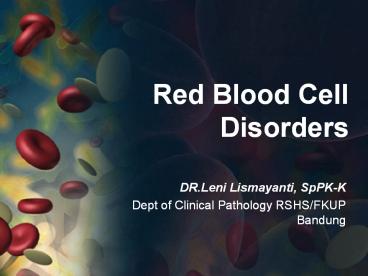Red Blood Cell Disorders - PowerPoint PPT Presentation
Title:
Red Blood Cell Disorders
Description:
Red Blood Cell Disorders DR.Leni Lismayanti, SpPK-K Dept of Clinical Pathology RSHS/FKUP Bandung Thank You Very Much for Your Attention Reference book ... – PowerPoint PPT presentation
Number of Views:491
Avg rating:3.0/5.0
Title: Red Blood Cell Disorders
1
Red Blood Cell Disorders
- DR.Leni Lismayanti, SpPK-K
- Dept of Clinical Pathology RSHS/FKUP Bandung
2
Reference book
- Denise M Harmening. Clinical Hematology and
Fundamental of Hemostasis. 5th edition.
Philadelphia FA Davis Co, 2009.
3
RBC Structure Function
- Areas of RBC metabolism important in normal RBC
survival and function - RBC membrane
- Hb structure function
- RBC metabolic pathway
4
RBC Membrane
- RBC membran proteins
- Deformability
- Permeability
- RBC membran lipids
- Phospholipd
- Glycolipid
- cholesterol
5
RBC membrane
6
Abnormality That Can Lead to a Change in RBC
Morphology
Abnormality RBC Morphology
Cholesterol accumulation in the RBC membrane (liver disease) Target cells
Abetalipoproteinemia with cholesterol accumulation Acanthocytes
LCAT deficiency with cholesterol accumulation Hemolysis with RBC fragmentation
Decreased phosphorylated spectrin or altered spectrin Bite cells and spherocytes
7
Hb Structure Function
Hb function delivery and release of oxygen to
the tissue and facilitation of CO2 excretion.
- Hb synhesis
- depends on 3 prs
- Adequate Iron delivery supply
- Adequate synthesis of protophorphyrin
- Adequate globin synthesis
8
RBC Metabolic Pathway
- ATP needs for
- Hb function
- Membrane integrity deformability
- RBC volume
- Adequate amounts of reduced pyridine nucleotides
- Protection of metabolic enzymes
9
RBC Senescence Hemolysis
- RBC traveles 200-300 miles during 120 day life
span ? undergo the process of senescence (aging)
? metabolic physical changes. - 1 RBC taken out (removed) from circulation by
RES/MPS ? process - Extravascular hemolysis (90)
- Intravascular hemolysis (5-10)
10
Extravascular Hemolysis
11
(No Transcript)
12
Any questions?
13
RBC Disorders
- Numbers
- Decreased (Anemia)
- Increased (Polycythemia)
- Structure and function
- Hemoglobin
- RBC membrane
- Abnormal erythropoiesis ? nutritional
RBC disorders ? morphologic changes
14
Anemia
- Inability of the circulating blood pool to supply
the tissue with adequate oxygen for proper
metabolic function. - Clinically d/ based on HT, SS, PE, Lab.
- Caused by or associated with underlying disease.
- Usually associated with decrease Hb Hct (Lab
RBC count). - Consideration by age, sex and other fact
15
Classification of Anemia
- Based on Hb level
- Moderate (7-10), severe (lt7).
- BM dynamic
- Hypoproliferative
- Accelerated destruction
- combination
- Clinically (caused)
- RBC indices (normochromic normocytic)
16
Categories of anemia by causes
- Blood loss
- Accelerated destruction
- Nutritional deficiency
- BM replacement
- Infection
- Toxicity
- Hematopoietic SC arrest/damage
- Hereditary/acquired defect
- idiopathic
17
Significance of Anemia and Compensatory Mechanism
- N 1 of RBC loss daily ? BM produce (measured by
reticulocyte count ? 0.5-2.0). - Replacement RBC requires
- Adequate functioning SC in BM
- Normal RBC maturation process
- Ability to release mature RBC from BM
18
- Proper HB RBC production requires
- Variety of nutritional factors
- Normal pathway of Bh synthesis
- In severe anemias ? symptoms of functional
impairment of several organs (). - Compensatory mechanism ? increase 2,3-DPG levels
19
2,3-DPG
- Physiologic regulator of
- Normal Hb oxygen-carrying capacity
- Tissue oxygen delivery
- 2,3-DPG () ? Hb more readily released oxygen to
tissues ? depend on pH Oxygen level of
arterial blood. - N individual responds to anemia ? elevated EPO ?
Recombinant EPO ? Th/ certain anemia.
20
Lab Tests in Diagnosis of Anemia
- Hb
- Hct
- (RBC Count)
- RBC indices
- Peripheral Blood Smear
- Reticulocyte Count
- BM smear/biopsy
Treatment of anemia depends on etiology
21
(No Transcript)
22
Polycythemia
- Polycythemia Vera (Myeloproliferative disorders).
- Secondary Hypoxic Polycythemia (Secondary
Erythrocytosis). - Relative Erythrocytosis.
23
Manifestations PV SE RE
CLINICAL FEATURES
Cyanosis Absent Present Maybe present
Heart/lung disease Absent Present Absent
Splenomegaly Present in 75 Absent Absent
Hepatomegaly Present in 35 Absent Absent
LAB FEATURES
RBC mass Increased Increased Normal
EPO Decreased (rarely N) Increased (rarely N) Normal
Arterial O2 saturation Normal Decreased Normal
WBC count Increased in 80 Normal Normal
Platelet count Increased in 50 Normal Normal
NRBCs poikilocytes Often present Absent Absent
LAP Increased in 70 Normal Normal
BM Hypercell eryth myelop ? Erythropoiesis ? Normal
Megakaryocytes ? fibrosis
Serum vit B12 Increased in 75 Normal Normal
Culture studies Autonomous, ery proliferation EPO dep.col.form Not applicable
24
Any questions?
25
- RBC Morphology
26
(No Transcript)
27
(No Transcript)
28
(No Transcript)
29
(No Transcript)
30
(No Transcript)
31
(No Transcript)
32
(No Transcript)
33
(No Transcript)
34
Thank You Very Much for Your Attention































